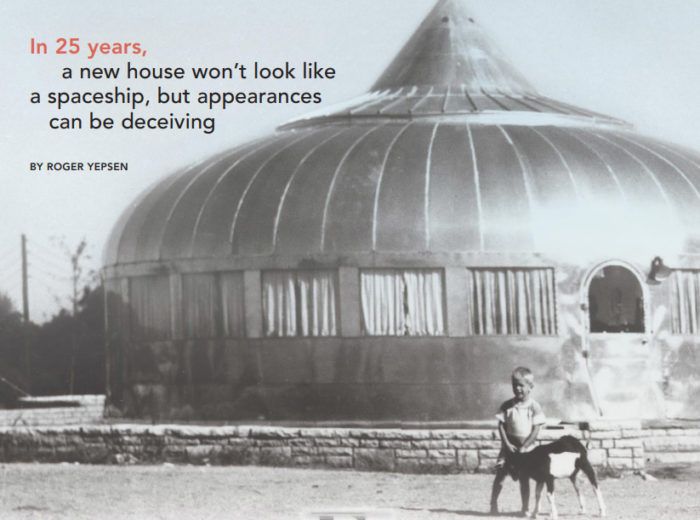The Future of Home Building
In 25 years, a new house won't look like a spaceship, but appearances can be deceiving.

Synopsis: Remember the Monsanto house? Buckminster Fuller’s Dymaxion house? The Jetsons? In the past, the home of the future was always a collection of gee-whiz technologies that never caught on with the general public. Roger Yepsen’s essay discusses the future of home building in terms of design, construction, and materials, and keeps his feet on the ground.
The future isn’t what it used to be—not when it comes to forecasting how houses will be built. In the past, Homes of Tomorrow showcased the gee-whiz technology of the moment. Reinforced concrete or steel or plate glass or plastics would deliver us to a better life. We had Mies van der Rohe’s minimalist boxes, Bucky Fuller’s Dymaxion Living Machine, the all metal Aluminaire House, and Philip Johnson’s fishbowl-as-home. In the 1950s, when Monsanto built its 30,000-lb. plastic House of the Future in Disneyland, Walt Disney suggested that Tomorrowland’s technological wonders could help to foster world peace.
As we move into a new millennium, Walt’s hopefulness sounds almost quaint. Homes of Tomorrow no longer seem to grab the public’s attention. Today, the best-known futuristic home is probably the Jetsons’ goofy space pad. We’ve lost the sense that home building can be a revolutionary means of improving society.
Even the future of home building itself is in question. We have fewer acres ripe for suburban development. Real-estate prices are escalating beyond the reach of many families. Traditional building materials are becoming scarce and expensive. Energy is an enormous concern: witness the record-high cost of oil, a nonrenewable resource whose supplies are finite and whose global demand is increasing. With even the way we build houses under scrutiny, it shouldn’t surprise anyone that design is going to be a big concern.
You’d feel at home in the future
Most consumer items play up technological bells and whistles, but our homes tend to conceal them. “We still like a house that looks like a house,” says Sarah Susanka, an architect whose Not So Big House gospel has gotten a great deal of attention. No matter where building science takes us, the home of the future probably will be packaged in a familiar, cozy form, not in the shape of a bubble or dome or Modernist slab. In part, this may be a reaction to the gangly solar homes of the 1970s, which tended to be overwhelmed by their good intentions. Similarly, A-frames, yurts, and domes haven’t aged well in the public’s eye. Forward-looking architects and builders still are forced to reckon with clients who would rather live in a Leave It to Beaver colonial than an envelope-stretching marvel.
Another factor behind the slow evolution of home design is the reality of 77 million retiring baby boomers. According to a recent survey, an overwhelming majority of this white-haired tide will choose to grow old in their present homes.
Accordingly, the home-building industry can be expected to show more interest in homes that enable living in place, according to Andy Kochera, senior policy analyst with the AARP’s Public Policy Institute. These homes will incorporate many senior-friendly features, such as single-floor living, excellent task lighting, and wheelchair level appliances, switches, and counters. Another potential barrier for older occupants is dealing with the sophisticated appliances and systems that the future certainly will bring. Robert Hodder, senior policy adviser on transportation and livable communities at AARP, predicts that because this generation of homeowners is defined more clearly as a special market, a broad range of products will be designed with them in mind.
For more photos and details on the future of home building, click the View PDF button below.
Fine Homebuilding Recommended Products
Fine Homebuilding receives a commission for items purchased through links on this site, including Amazon Associates and other affiliate advertising programs.

Plate Level

Anchor Bolt Marker

100-ft. Tape Measure


























View Comments
Edinburgh is one of the best places to invest in residential property within the UK Edinburgh real estate prices have been rising steadily, but Edinburgh properties can still be purchased at a fraction of London prices.Investing in Edinburgh does not have to be difficult! We can introduce you to solicitors, accountants, and mortgage advisors, and then take care of any refurbishment works, if necessary. Some of our investors have never been to Edinburgh!